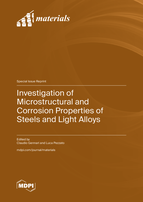Investigation of Microstructural and Corrosion Properties of Steels and Light Alloys
A special issue of Materials (ISSN 1996-1944). This special issue belongs to the section "Metals and Alloys".
Deadline for manuscript submissions: closed (10 August 2023) | Viewed by 18150
Special Issue Editors
Interests: electroplastic effect; duplex stainless steel; TRIP steel; materials characterization
Special Issues, Collections and Topics in MDPI journals
Interests: corrosion; coatings; steels; ligth alloys
Special Issues, Collections and Topics in MDPI journals
Special Issue Information
Dear Colleagues,
Very few metals can be found in metallic form in nature; the vast majority have to be processed from their ores at a great cost in terms of energy and money. It is therefore energetically favorable for them to reverse to their initial state. This process is commonly known as corrosion or anti-metallurgy, and great efforts are made worldwide to limit this process.
According to the latest NACE estimation (2013), the global cost for corrosion is equivalent to approximately 3.4% of the global GDP (2.5 trillion US$) not considering environmental consequences or safety issues. A reduction between 15% and 35% could be realized if prevention techniques and proper precaution are used, which means savings between US$375 and $875 billion. Corrosion involves different sectors such as industry, military, civilian, services, etc., in particular energy production, transport, chemical and petrochemical industries, the mechanical industry, and drink and beverage. Among these sectors, most of the constituents are made out of steel, which is the most produced metal in the world (1808 million tons in 2018) or light alloys, mainly aluminium (60.1 million tons consumption in 2018).
A proper alloy design in terms of composition, heat treatments, microstructural features, etc. is mandatory in order to obtain the best combination of mechanical properties and corrosion resistance during operation, reducing maintenance costs and the overall impact on the global economy. In fact, microstructural features can affect both the corrosion of the material itself and also the eventual production of protective layers on their surfaces.
The purpose of this Special Issue is to correlate the key role of the microstructure of steels and light alloys to their corrosion properties.
I invite you to submit both original contributions and review works on this topic, with papers that deal both with the characterization and with corrosion resistance evaluation of different alloys.
Dr. Claudio Gennari
Dr. Luca Pezzato
Guest Editors
Manuscript Submission Information
Manuscripts should be submitted online at www.mdpi.com by registering and logging in to this website. Once you are registered, click here to go to the submission form. Manuscripts can be submitted until the deadline. All submissions that pass pre-check are peer-reviewed. Accepted papers will be published continuously in the journal (as soon as accepted) and will be listed together on the special issue website. Research articles, review articles as well as short communications are invited. For planned papers, a title and short abstract (about 100 words) can be sent to the Editorial Office for announcement on this website.
Submitted manuscripts should not have been published previously, nor be under consideration for publication elsewhere (except conference proceedings papers). All manuscripts are thoroughly refereed through a single-blind peer-review process. A guide for authors and other relevant information for submission of manuscripts is available on the Instructions for Authors page. Materials is an international peer-reviewed open access semimonthly journal published by MDPI.
Please visit the Instructions for Authors page before submitting a manuscript. The Article Processing Charge (APC) for publication in this open access journal is 2600 CHF (Swiss Francs). Submitted papers should be well formatted and use good English. Authors may use MDPI's English editing service prior to publication or during author revisions.
Keywords
- corrosion resistance
- steels
- light alloys
- microstructure
- critical pitting temperature (CPT)
- heat treatments
- corrosion inhibitors
- surface treatments








